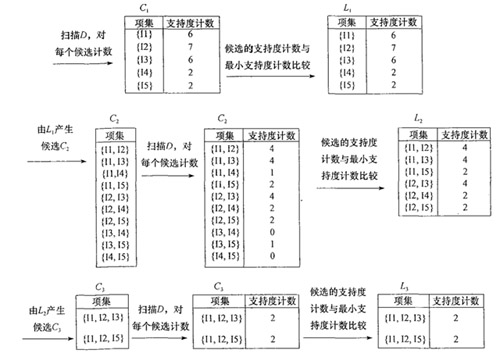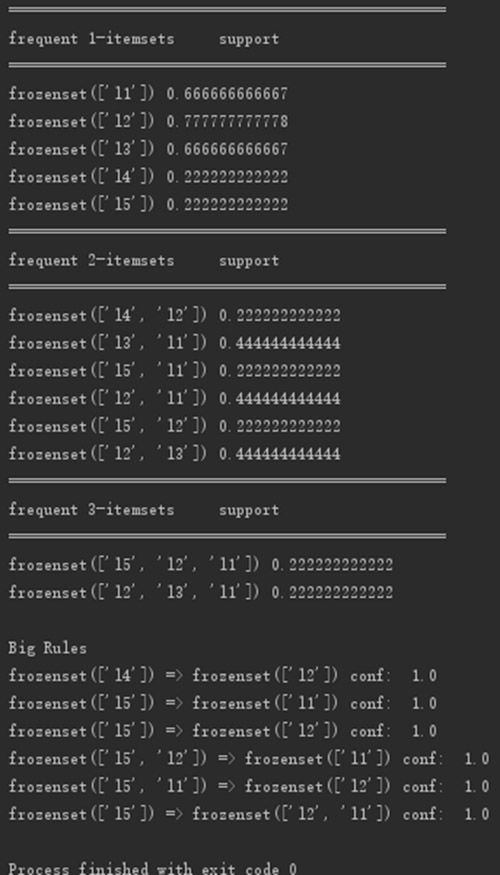随着大数据概念的火热,啤酒与尿布的故事广为人知。我们如何发现买啤酒的人往往也会买尿布这一规律?数据挖掘中的用于挖掘频繁项集和关联规则的Apriori算法可以告诉我们。本文首先对Apriori算法进行简介,而后进一步介绍相关的基本概念,之后详细的介绍Apriori算法的具体策略和步骤,***给出Python实现代码。
1.Apriori算法简介
Apriori算法是经典的挖掘频繁项集和关联规则的数据挖掘算法。A priori在拉丁语中指”来自以前”。当定义问题时,通常会使用先验知识或者假设,这被称作”一个先验”(a priori)。Apriori算法的名字正是基于这样的事实:算法使用频繁项集性质的先验性质,即频繁项集的所有非空子集也一定是频繁的。Apriori算法使用一种称为逐层搜索的迭代方法,其中k项集用于探索(k+1)项集。首先,通过扫描数据库,累计每个项的计数,并收集满足最小支持度的项,找出频繁1项集的集合。该集合记为L1。然后,使用L1找出频繁2项集的集合L2,使用L2找出L3,如此下去,直到不能再找到频繁k项集。每找出一个Lk需要一次数据库的完整扫描。Apriori算法使用频繁项集的先验性质来压缩搜索空间。
2. 基本概念
项与项集:设itemset={item1, item_2, …, item_m}是所有项的集合,其中,item_k(k=1,2,…,m)成为项。项的集合称为项集(itemset),包含k个项的项集称为k项集(k-itemset)。
事务与事务集:一个事务T是一个项集,它是itemset的一个子集,每个事务均与一个唯一标识符Tid相联系。不同的事务一起组成了事务集D,它构成了关联规则发现的事务数据库。
关联规则:关联规则是形如A=>B的蕴涵式,其中A、B均为itemset的子集且均不为空集,而A交B为空。
支持度(support):关联规则的支持度定义如下:
其中P(A∪B)表示事务包含集合A和B的并(即包含A和B中的每个项)的概率。注意与P(A or B)区别,后者表示事务包含A或B的概率。
置信度(confidence):关联规则的置信度定义如下:
项集的出现频度(support count):包含项集的事务数,简称为项集的频度、支持度计数或计数。
频繁项集(frequent itemset):如果项集I的相对支持度满足事先定义好的最小支持度阈值(即I的出现频度大于相应的最小出现频度(支持度计数)阈值),则I是频繁项集。
强关联规则:满足最小支持度和最小置信度的关联规则,即待挖掘的关联规则。
3. 实现步骤
一般而言,关联规则的挖掘是一个两步的过程:
找出所有的频繁项集
由频繁项集产生强关联规则
3.1挖掘频繁项集
3.1.1 相关定义
- 连接步骤:频繁(k-1)项集Lk-1的自身连接产生候选k项集Ck
Apriori算法假定项集中的项按照字典序排序。如果Lk-1中某两个的元素(项集)itemset1和itemset2的前(k-2)个项是相同的,则称itemset1和itemset2是可连接的。所以itemset1与itemset2连接产生的结果项集是{itemset1[1], itemset1[2], …, itemset1[k-1], itemset2[k-1]}。连接步骤包含在下文代码中的create_Ck函数中。
- 剪枝策略
由于存在先验性质:任何非频繁的(k-1)项集都不是频繁k项集的子集。因此,如果一个候选k项集Ck的(k-1)项子集不在Lk-1中,则该候选也不可能是频繁的,从而可以从Ck中删除,获得压缩后的Ck。下文代码中的is_apriori函数用于判断是否满足先验性质,create_Ck函数中包含剪枝步骤,即若不满足先验性质,剪枝。
- 删除策略
基于压缩后的Ck,扫描所有事务,对Ck中的每个项进行计数,然后删除不满足最小支持度的项,从而获得频繁k项集。删除策略包含在下文代码中的generate_Lk_by_Ck函数中。
3.1.2 步骤
- 每个项都是候选1项集的集合C1的成员。算法扫描所有的事务,获得每个项,生成C1(见下文代码中的create_C1函数)。然后对每个项进行计数。然后根据最小支持度从C1中删除不满足的项,从而获得频繁1项集L1。
- 对L1的自身连接生成的集合执行剪枝策略产生候选2项集的集合C2,然后,扫描所有事务,对C2中每个项进行计数。同样的,根据最小支持度从C2中删除不满足的项,从而获得频繁2项集L2。
- 对L2的自身连接生成的集合执行剪枝策略产生候选3项集的集合C3,然后,扫描所有事务,对C3每个项进行计数。同样的,根据最小支持度从C3中删除不满足的项,从而获得频繁3项集L3。
- 以此类推,对Lk-1的自身连接生成的集合执行剪枝策略产生候选k项集Ck,然后,扫描所有事务,对Ck中的每个项进行计数。然后根据最小支持度从Ck中删除不满足的项,从而获得频繁k项集。
3.2 由频繁项集产生关联规则
一旦找出了频繁项集,就可以直接由它们产生强关联规则。产生步骤如下:
- 对于每个频繁项集itemset,产生itemset的所有非空子集(这些非空子集一定是频繁项集);
- 对于itemset的每个非空子集s,如果
则输出s=>(l-s),其中min_conf是最小置信度阈值。
4. 样例以及Python实现代码
下图是《数据挖掘:概念与技术》(第三版)中挖掘频繁项集的样例图解。
本文基于该样例的数据编写Python代码实现Apriori算法。代码需要注意如下两点:
由于Apriori算法假定项集中的项是按字典序排序的,而集合本身是无序的,所以我们在必要时需要进行set和list的转换;
由于要使用字典(support_data)记录项集的支持度,需要用项集作为key,而可变集合无法作为字典的key,因此在合适时机应将项集转为固定集合frozenset。
- """
- # Python 2.7
- # Filename: apriori.py
- # Author: llhthinker
- # Email: hangliu56[AT]gmail[DOT]com
- # Blog: http://www.cnblogs.com/llhthinker/p/6719779.html
- # Date: 2017-04-16
- """
- def load_data_set():
- """
- Load a sample data set (From Data Mining: Concepts and Techniques, 3th Edition)
- Returns:
- A data set: A list of transactions. Each transaction contains several items.
- """
- data_set = [['l1', 'l2', 'l5'], ['l2', 'l4'], ['l2', 'l3'],
- ['l1', 'l2', 'l4'], ['l1', 'l3'], ['l2', 'l3'],
- ['l1', 'l3'], ['l1', 'l2', 'l3', 'l5'], ['l1', 'l2', 'l3']]
- return data_set
- def create_C1(data_set):
- """
- Create frequent candidate 1-itemset C1 by scaning data set.
- Args:
- data_set: A list of transactions. Each transaction contains several items.
- Returns:
- C1: A set which contains all frequent candidate 1-itemsets
- """
- C1 = set()
- for t in data_set:
- for item in t:
- item_set = frozenset([item])
- C1.add(item_set)
- return C1
- def is_apriori(Ck_item, Lksub1):
- """
- Judge whether a frequent candidate k-itemset satisfy Apriori property.
- Args:
- Ck_item: a frequent candidate k-itemset in Ck which contains all frequent
- candidate k-itemsets.
- Lksub1: Lk-1, a set which contains all frequent candidate (k-1)-itemsets.
- Returns:
- True: satisfying Apriori property.
- False: Not satisfying Apriori property.
- """
- for item in Ck_item:
- sub_Ck = Ck_item - frozenset([item])
- if sub_Ck not in Lksub1:
- return False
- return True
- def create_Ck(Lksub1, k):
- """
- Create Ck, a set which contains all all frequent candidate k-itemsets
- by Lk-1's own connection operation.
- Args:
- Lksub1: Lk-1, a set which contains all frequent candidate (k-1)-itemsets.
- k: the item number of a frequent itemset.
- Return:
- Ck: a set which contains all all frequent candidate k-itemsets.
- """
- Ck = set()
- len_Lksub1 = len(Lksub1)
- list_Lksub1 = list(Lksub1)
- for i in range(len_Lksub1):
- for j in range(1, len_Lksub1):
- l1 = list(list_Lksub1[i])
- l2 = list(list_Lksub1[j])
- l1.sort()
- l2.sort()
- if l1[0:k-2] == l2[0:k-2]:
- Ck_item = list_Lksub1[i] | list_Lksub1[j]
- # pruning
- if is_apriori(Ck_item, Lksub1):
- Ck.add(Ck_item)
- return Ck
- def generate_Lk_by_Ck(data_set, Ck, min_support, support_data):
- """
- Generate Lk by executing a delete policy from Ck.
- Args:
- data_set: A list of transactions. Each transaction contains several items.
- Ck: A set which contains all all frequent candidate k-itemsets.
- min_support: The minimum support.
- support_data: A dictionary. The key is frequent itemset and the value is support.
- Returns:
- Lk: A set which contains all all frequent k-itemsets.
- """
- Lk = set()
- item_count = {}
- for t in data_set:
- for item in Ck:
- if item.issubset(t):
- if item not in item_count:
- item_count[item] = 1
- else:
- item_count[item] += 1
- t_num = float(len(data_set))
- for item in item_count:
- if (item_count[item] / t_num) >= min_support:
- Lk.add(item)
- support_data[item] = item_count[item] / t_num
- return Lk
- def generate_L(data_set, k, min_support):
- """
- Generate all frequent itemsets.
- Args:
- data_set: A list of transactions. Each transaction contains several items.
- k: Maximum number of items for all frequent itemsets.
- min_support: The minimum support.
- Returns:
- L: The list of Lk.
- support_data: A dictionary. The key is frequent itemset and the value is support.
- """
- support_data = {}
- C1 = create_C1(data_set)
- L1 = generate_Lk_by_Ck(data_set, C1, min_support, support_data)
- Lksub1 = L1.copy()
- L = []
- L.append(Lksub1)
- for i in range(2, k+1):
- Ci = create_Ck(Lksub1, i)
- Li = generate_Lk_by_Ck(data_set, Ci, min_support, support_data)
- Lksub1 = Li.copy()
- L.append(Lksub1)
- return L, support_data
- def generate_big_rules(L, support_data, min_conf):
- """
- Generate big rules from frequent itemsets.
- Args:
- L: The list of Lk.
- support_data: A dictionary. The key is frequent itemset and the value is support.
- min_conf: Minimal confidence.
- Returns:
- big_rule_list: A list which contains all big rules. Each big rule is represented
- as a 3-tuple.
- """
- big_rule_list = []
- sub_set_list = []
- for i in range(0, len(L)):
- for freq_set in L[i]:
- for sub_set in sub_set_list:
- if sub_set.issubset(freq_set):
- conf = support_data[freq_set] / support_data[freq_set - sub_set]
- big_rule = (freq_set - sub_set, sub_set, conf)
- if conf >= min_conf and big_rule not in big_rule_list:
- # print freq_set-sub_set, " => ", sub_set, "conf: ", conf
- big_rule_list.append(big_rule)
- sub_set_list.append(freq_set)
- return big_rule_list
- if __name__ == "__main__":
- """
- Test
- """
- data_set = load_data_set()
- L, support_data = generate_L(data_set, k=3, min_support=0.2)
- big_rules_list = generate_big_rules(L, support_data, min_conf=0.7)
- for Lk in L:
- print "="*50
- print "frequent " + str(len(list(Lk)[0])) + "-itemsets\t\tsupport"
- print "="*50
- for freq_set in Lk:
- print freq_set, support_data[freq_set]
- print "Big Rules"
- for item in big_rules_list:
- print item[0], "=>", item[1], "conf: ", item[2]
代码运行结果截图如下:





































